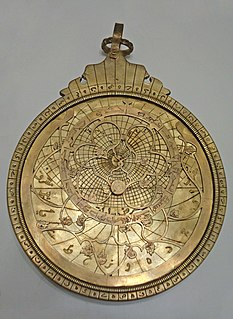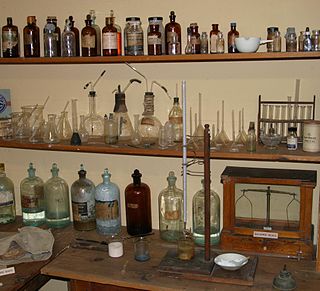
Brass is an alloy of copper (Cu) and zinc (Zn), in proportions which can be varied to achieve varying mechanical, electrical, and chemical properties. It is a substitutional alloy: atoms of the two constituents may replace each other within the same crystal structure.

Bronze is an alloy consisting primarily of copper, commonly with about 12–12.5% tin and often with the addition of other metals and sometimes non-metals, such as phosphorus, or metalloids such as arsenic or silicon. These additions produce a range of alloys that may be harder than copper alone, or have other useful properties, such as strength, ductility, or machinability.

Brazing is a metal-joining process in which two or more metal items are joined together by melting and flowing a filler metal into the joint, with the filler metal having a lower melting point than the adjoining metal.

Bronze is the most popular metal for cast metal sculptures; a cast bronze sculpture is often called simply "a bronze". It can be used for statues, singly or in groups, reliefs, and small statuettes and figurines, as well as bronze elements to be fitted to other objects such as furniture. It is often gilded to give gilt-bronze or ormolu.

Gilding is a decorative technique for applying a very thin coating of gold over solid surfaces such as metal, wood, porcelain, or stone. A gilded object is also described as "gilt". Where metal is gilded, the metal below was traditionally silver in the West, to make silver-gilt objects, but gilt-bronze is commonly used in China, and also called ormolu if it is Western. Methods of gilding include hand application and gluing, typically of gold leaf, chemical gilding, and electroplating, the last also called gold plating. Parcel-gilt objects are only gilded over part of their surfaces. This may mean that all of the inside, and none of the outside, of a chalice or similar vessel is gilded, or that patterns or images are made up by using a combination of gilt and ungilted areas.

Repoussé or repoussage is a metalworking technique in which a malleable metal is shaped by hammering from the reverse side to create a design in low relief. Chasing or embossing is a similar technique in which the piece is hammered on the front side, sinking the metal. The two techniques are often used in conjunction.

Cloisonné is an ancient technique for decorating metalwork objects with colored material held in place or separated by metal strips or wire, normally of gold. In recent centuries, vitreous enamel has been used, but inlays of cut gemstones, glass and other materials were also used during older periods; indeed cloisonné enamel very probably began as an easier imitation of cloisonné work using gems. The resulting objects can also be called cloisonné. The decoration is formed by first adding compartments to the metal object by soldering or affixing silver or gold as wires or thin strips placed on their edges. These remain visible in the finished piece, separating the different compartments of the enamel or inlays, which are often of several colors. Cloisonné enamel objects are worked on with enamel powder made into a paste, which then needs to be fired in a kiln. If gemstones or colored glass are used, the pieces need to be cut or ground into the shape of each cloison.

Shakudō (赤銅) is a Japanese billon of gold and copper, one of the irogane class of colored metals, which can be treated to develop a black, or sometimes indigo, patina, resembling lacquer. Unpatinated shakudō visually resembles bronze; the dark color is induced by the niiro artificial patination process, involving boiling in a solution, generally including rokushō.
The fineness of a precious metal object represents the weight of fine metal therein, in proportion to the total weight which includes alloying base metals and any impurities. Alloy metals are added to increase hardness and durability of coins and jewelry, alter colors, decrease the cost per weight, or avoid the cost of high-purity refinement. For example, copper is added to the precious metal silver to make a more durable alloy for use in coins, housewares and jewelry. Coin silver, which was used for making silver coins in the past, contains 90% silver and 10% copper, by mass. Sterling silver contains 92.5% silver and 7.5% of other metals, usually copper, by mass.
Rokushō (緑青) is a traditional Japanese chemical compound used in the niiro process for artificially inducing patination in decorative non-ferrous metals, especially several copper alloys, with the results being metals of the irogane class. These "colour metals," virtually unknown outside Japan until the late 19th century, have achieved some popularity in craft circles in other parts of the world since then.

Shibuichi (四分一) is a historically Japanese copper alloy, a member of the irogane class, which is patinated into a range of subtle greys and muted shades of blue, green, and brown, through the use of niiro processes, involving the rokushō compound.
Argentium silver is a brand of modern tarnish-resistant silver alloys, containing either 93.5% or 96% silver. Argentium alloys replace some of the copper in the traditional sterling silver alloy with the metalloid germanium. Argentium's patents refer to percentages of zinc and boron present in Argentium silver. Both Argentium alloys exceed the standard required for hallmarking as sterling silver and Argentium silver 960 meets the standard for hallmarking as Britannia silver.
Silver standards refer to the standards of millesimal fineness for the silver alloy used in the manufacture or crafting of silver objects. This list is organized from highest to lowest millesimal fineness, or purity of the silver.

Pure gold is slightly reddish yellow in color, but colored gold in various other colors can be produced by alloying gold with other elements.

A metallurgical assay is a compositional analysis of an ore, metal, or alloy, usually performed in order to test for purity or quality.

Soldering is a process in which two or more items are joined by melting and putting a filler metal (solder) into the joint, the filler metal having a lower melting point than the adjoining metal. Unlike welding, soldering does not involve melting the work pieces. In brazing, the work piece metal also does not melt, but the filler metal is one that melts at a higher temperature than in soldering. In the past, nearly all solders contained lead, but environmental and health concerns have increasingly dictated use of lead-free alloys for electronics and plumbing purposes.
Rio Grande is a jewelry-making equipment, tools and supplies company located in Albuquerque, New Mexico. Founded in 1944 by jeweler Saul Bell, the company is run by six directors and has become one of the largest jewelry findings, tools, and equipment suppliers in the world.
Painting with Fire (PWF) is the name given to an immersion process for creating torch fired enamel jewelry. This process is the focal point of torch fired enamel jewelry workshops taught by Barbara A. Lewis, written about in her book, and discussed in Belle Armoire Jewelry, Handcrafted Jewelry, Bead Trends, Stringing and Bead Unique.

Granulation is a jewellery manufacturing technique whereby a surface is covered in spherules or granules of precious metal. The technique is thought to have its origins in Sumer about 5,000 years ago. This technique then spread to southern Europe during the orientalizing period, also through the role of Phoenicians, who had founded colonies in Sardinia, Sicily and Spain, or Near Eastern craftsmen.













